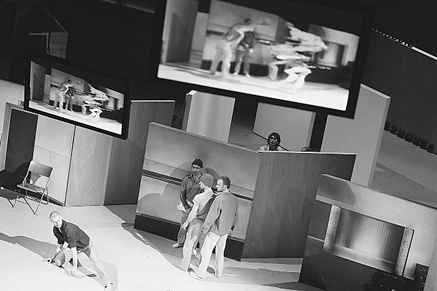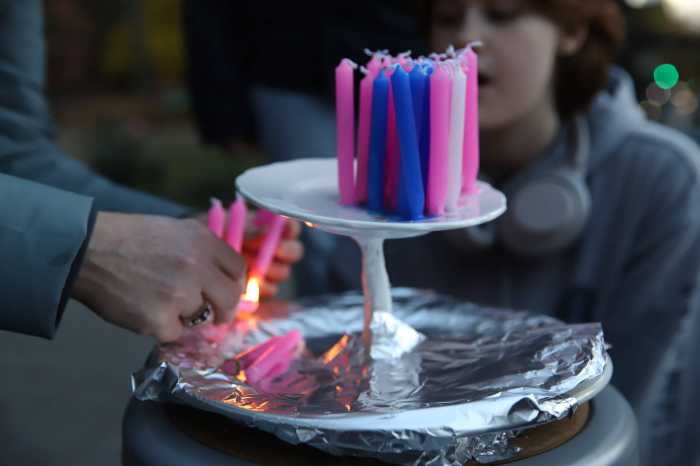William Forsythe’s cutting edge leaves a new scar
While the dancers stretch and tumble, Antony Rizzi is on the soapbox as we enter the house on opening night, May 2. BAM’s Next Wave Festival offered the100 minute “Kammer/Kammer” by pioneering American born, postmodern ballet choreographer William Forsythe. From the ashes of Ballet Frankfurt, the new Forsythe Company found new homes—and sources of support—in Germany. Rizzi’s biting humor takes aim. We like to laugh at ourselves, right?
Embracing his adopted European home, which he locates at the epicenter of the dance world, Rizzi jokes about wanting to give back to the American people. The chatter grabs our attention but gets our goat. It’s intended to “put us at ease… to seduce us,” says Forsythe in his program notes. Bring on the dancing; we are prepared.
Rizzo plays the needy, nebbish boyfriend-of-a-rock-star narrator from “Outline of My Lover,” the Douglas Martin first novel that inspired Forsythe. Unlike the unassuming and almost invisible character in the Martin novel, Rizzi is in our face, and only sometimes funny.
After souring with sarcasm, “Kammer/Kammer” wows with incredible video tricks and Dana Caspersen, who melts our hearts and stimulates our minds playing Catherine Deneuve. “Beginnings are hard,” she says.
The dance juxtaposes Martin’s novel and a poetic essay by Anne Carson, “Irony is Not Enough: My Life as Catherine Deneuve,” in which Deneuve is a professor of classic poetry. Also appropriated is a student film by Martin Schwember called “First Touch” in which a boy wishes he could play the violin but wasn’t allowed lessons as a child. Forsythe weaves these tales about unrequited love and balances of power—boldly reopening his characters’ raw vulnerability—with movement, stagecraft, music, and video.
The dancers are hidden from view behind a scrim and we see them in video screens. The close-up view is more intimate, but the many flat screens remind us we’re in a theater whose grand scale resists the intimacy that is the dance’s subject. What we long for most is bodies, dancing, and the visceral pleasure that’s being withheld.
Rizzi calls the dancers out in his opening monologue, saying, “Come on, this is dance-theater,” and by the end of the piece we’re convinced of the virtuosity of their now signature physicality and artistry. In “Kammer” they evince the struggles in relationships, the give-and-take, and the hurt.
Scwember lies back on a hotel mattress playing the violin—an image recreated from his film. Mattresses also serve as buoyant platforms, adding considerable spring to the dancers bouncing and tumbling, and redefining the ballon, or elevation in ballet. With this new method, the pelvis can sensuously, vulnerably jut out to the back. Though improvisational-looking, the movement is rigorous and tightly choreographed. Says Forsythe after, “You’d get your teeth knocked out if you weren’t careful.”
Caspersen’s refined stature embodies a steamy romance that’s “mental,” with a girl in her class danced by Jone San Martin who speaks with a halting French accent. San Martin senses the effect she has—proceeding with caution. Caspersen delivering Carson’s lines—while moving around the stage in bare feet, slim beige wool skirt, and beige shell top—is pure poetry. She lies on the mattress and our eyes head for her hemline and the darkness around her legs, which swimmingly move like breathing.
Richard Siegal’s funky style and wild solos of Aymen Harper transfix. In the heartening music, Caspersen lip-synchs Lynn Anderson’s “Cry,” and the violinist masters J.S. Bach.
“Meanwhile the body persists,” recites Caspersen. In the juggling of intimacy and avoidance, a circular pattern is achieved and finally, as in Carson’s essay, “comes a knock on the door.”
gaycitynews.com




































